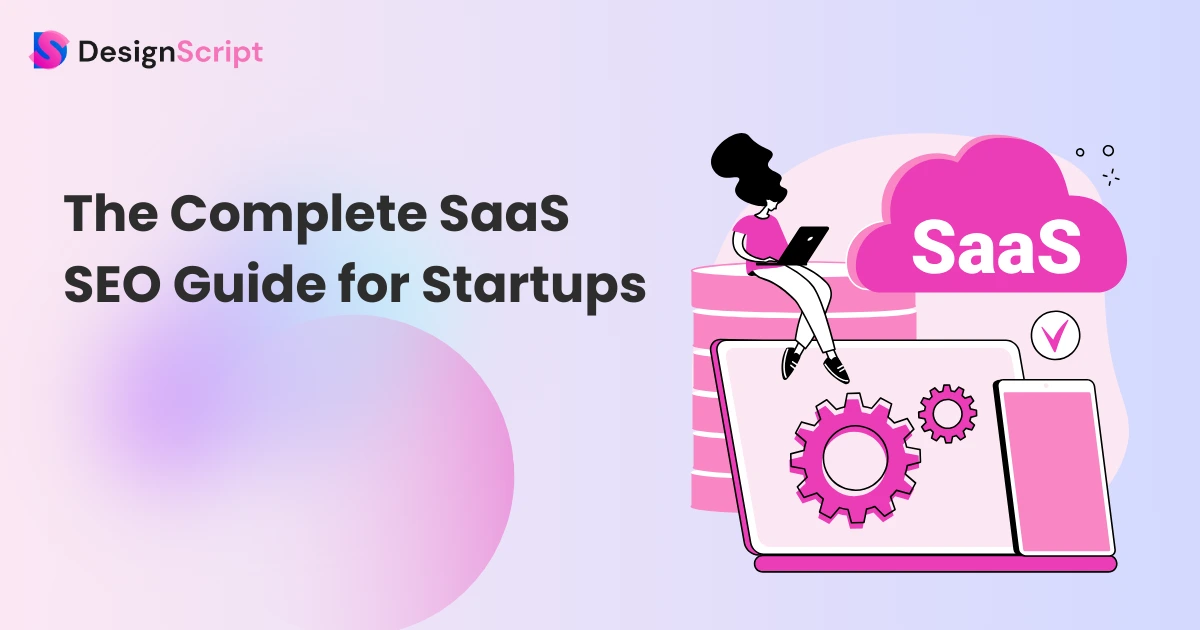The Complete SaaS SEO Guide for Startups
Have you ever wondered how some startups skyrocket to success while others struggle to take off? The answer might lie in something you’ve heard of but need to become more familiar with: SaaS SEO.
Imagine having an amazing product or service, but your potential customers cannot find you in the digital landscape. That’s where SEO (Search Engine Optimization) plays its part – think of it as the guide that directs your desired audience to your virtual doorstep.
In today’s competitive online market, overlooking SaaS SEO could mean leaving your startup’s destiny to chance. Without a solid SEO strategy, your groundbreaking solution might be invisible. But don’t fear because this blog is your ultimate beginner’s guide to SaaS SEO for startups.
In this SaaS SEO guide for startups, we’ll explore the mysteries of SEO, break down its relevance for Software as a Service (SaaS) companies, and provide simple yet effective tips to enhance your online visibility.
Let’s begin!
Table of Contents
- What Is SaaS SEO?
- What Makes SEO For SaaS Companies Unique?
- Why Should Startups Invest In SEO?
- Implementing SEO for SaaS Startups
- Step 1: Identify Jobs to Be Done(JTBD)
- Step 2: Perform Initial SEO Research
- Step 3: Build Your Content Pillar Pages
- Step 4: Build Your Cluster Pages
- Step 5: Use Gated Content to Get Qualified Leads
- Step 6: Implement a Content Nurturing Strategy
- Step 7: Optimize Down-Funnel Content
- Step 8: Implement a Link Building Strategy
- Step 9: Use a Paid Acquisition Strategy
- Step 10: Measure, Analyze, and Repeat
- SaaS SEO Best Practices for Startups
- 5 Ranking Factors for SaaS Startups
- Most Common SEO Mistakes Of SaaS Startups
What Is SaaS SEO?
SaaS SEO is a special way SaaS companies use to become more visible online. It helps them show up better in searches and connect with the people they want to reach. In an era dominated by online interactions, the success of SaaS companies depends on their ability to be discovered easily by potential customers. So, this is where SaaS SEO steps in.
A SaaS SEO strategy involves various techniques, including content marketing, keyword optimization, and technical optimizations. All these strategies elevate a SaaS company’s organic traffic. Organic traffic means people who find a website naturally through search engines. It’s important because these visitors could turn into customers.
SaaS SEO primarily aims to enhance a platform’s visibility in organic search results to connect with various types of potential customers:
- Individuals actively seeking your software: These searchers are already aware of your existence and are looking to gather more information about what you offer.
- People seeking information about software similar to yours: These individuals know about software like yours and are in the research phase to determine if it suits their requirements.
- Prospective buyers ready to make a software purchase: This group specifically investigates pricing, deals, and features before making a final decision.
- Those interested in content related to your software: Although they aren’t actively looking for software like yours, they are searching for content related to your field. While they might only need your software after a while, there’s potential for them to become customers down the line.
What Makes SEO For SaaS Companies Unique?
SEO for SaaS companies has the unique characteristics that set it apart from regular SEO:
- Complexity of Services: SaaS products can be complex. SEO for SaaS requires a deep understanding of the software’s features, benefits, and user problems it solves. It means keyword research and content creation need to be highly targeted.
- Longer Sales Cycles: SaaS sales often involve longer decision-making processes. SEO for SaaS needs to nurture leads through informative content and solutions-based approaches to address potential customers at various sales funnel stages.
- Competitive Landscape: The SaaS market can be fiercely competitive. SEO strategies must focus on ranking high and differentiating the product from competitors.
- Product Updates: Frequent product updates and new features mean SEO should be adaptable and able to highlight these changes to keep the content fresh and relevant.
- Subscription-Based Model: Unlike one-time purchases, SaaS relies on subscriptions. SEO needs to emphasize value over time to retain customers.
Why Should Startups Invest In SEO?

In this SaaS SEO guide for startups, you will explore the importance of discovering the significant advantages of investing in SEO. This strategic move isn’t just for the tech giants; it’s a solid approach for budding ventures to establish a solid online presence and thrive. Here’s why SaaS startups should consider putting their resources into SEO:
1. Increases Organic Traffic to Your Site
The heart of SEO lies in boosting organic traffic to your website. Through keyword optimization and content creation, a well-structured SaaS SEO strategy helps your site climb the search results ladder, making it easier for potential customers to discover your SaaS product or solution.
2. Creates Brand Awareness
Effective SEO doesn’t just drive clicks; it generates awareness. Your startup gains visibility by appearing prominently in search results, and users become familiar with your brand. This brand recognition can be a powerful asset as your SaaS product gains popularity in the market.
3. Is Cost-Effective
For startups with limited budgets, cost-effectiveness is a prime concern. SEO stands out in this regard. While initially demanding time and effort, the long-term benefits are substantial. Once your SaaS SEO strategy is in place, the continuous flow of organic traffic and leads becomes a sustainable asset without the ongoing costs of paid advertising.
4. Helps Handle Competition
In the competitive SaaS landscape, being found ahead of competitors is crucial. With a well-executed SaaS SEO strategy, you can secure a prime spot in search engine rankings, ensuring users discover your solution before alternatives.
5. Focuses on the Entire Marketing Funnel
SaaS SEO isn’t just about traffic; it’s about qualified traffic. A thoughtful approach involves optimizing your content for various stages of the buyer’s journey, from awareness to decision-making. It ensures that users are engaged and nurtured throughout their interaction with your brand.
6. Helps Achieve the Highest ROI
Return on Investment (ROI) is a pivotal metric for startups. SEO, known for delivering exceptional ROI, offers a multiplier effect. The efforts put into content creation, SaaS SEO strategy, and link building pay off as organic traffic flows in, generating leads and, eventually, customers.
7. Boosts Site’s Domain Authority
SEO isn’t just about keywords; it’s about authority. As your site gains credibility through quality content and backlinks, its domain authority increases. It leads to improved search rankings and an overall stronger online presence.
8. Increases Customer Retention Rate
SEO isn’t solely about attracting new customers; it’s about retaining them too. By consistently offering valuable content and addressing user needs, you build a loyal customer base that keeps coming back for insights and solutions.
Implementing SEO for SaaS Startups
Let’s explore implementing SEO for SaaS startups!

Step 1: Identify Jobs to Be Done(JTBD)
The first step in implementing SEO for your SaaS startup is understanding the Jobs to Be Done (JTBD) – essentially, what problems your software solves for your customers. It is the foundation on which your entire SEO strategy will be built. Ask yourself: What pain points does your SaaS product address? How does it make your users’ lives easier? This clarity will guide your keyword research and content creation. When it comes to SEO objectives, they can vary depending on different factors. Here are some common objectives to consider:
- Increasing Organic Traffic: The aim is to bring more visitors to your website. It provides more chances to turn them into potential customers.
- Lead Generation for Startups: Your content should convince as many people as possible to share their email addresses. It is essential for both building contacts and driving customer acquisition.
- Building Brand Awareness: It’s about getting more people to know your brand by attracting them to your content.
- Boosting Sales: The focus is driving the right traffic to maximize sales.
- Enhancing Customer Service: Your content can target individuals seeking specific solutions.
- Managing Reputation: The objective is to ensure your startup’s positive reputation by ranking high on branded keywords and pushing down negative content.
Step 2: Perform Initial SEO Research

Conduct thorough SEO research to pave the way for success in this crucial step. Start by identifying keywords relevant to your startup’s offerings.
Use platforms like Google Keyword Planner to discover high-potential keywords with decent search volumes. Analyze search intent – understand what users seek when using these keywords. Explore competitor strategies using platforms like SEMrush or Ahrefs to uncover valuable insights. This research will guide your content creation, effectively helping you address your target audience’s needs.
Additionally, delve into backlink opportunities by assessing your industry’s authoritative websites. Ultimately, this initial research lays the foundation for a tailored SaaS SEO strategy that aligns with your startup’s goals and audience.
Step 3: Build Your Content Pillar Pages

Construct your content pillar pages as the sturdy foundation of your website. These comprehensive pages cover broad topics central to your business. They gather essential information, making it easily accessible for your visitors.
Organizing related subtopics and details around a core theme creates a user-friendly structure that humans and search engines appreciate. Content pillar pages enhance your website’s authority, credibility, and SEO performance. They’re like guideposts directing your audience and search engines toward your offer.
Creating organized pillar pages offers important information and expands the likelihood of appearing higher in search results. This makes it easier for your intended audience to quickly find what they’re searching for.
Step 4: Build Your Cluster Pages

Cluster pages delve deeper into specific subtopics related to your content pillar. Think of them as branches stemming from the central pillar.
Each cluster page covers a narrower subject, providing more detailed information. By interlinking these cluster pages with your pillar and each other, you create a web of valuable content that’s easy to navigate. This helps your visitors find relevant information and boosts your SEO by showing search engines that the content is interconnected.
Step 5: Use Gated Content to Get Qualified Leads

Gated content holds valuable resources your audience desires, such as eBooks, whitepapers, or exclusive guides. To access this content, visitors provide their contact information. It is a win-win: your audience gains valuable insights, and you acquire qualified leads. These leads are more likely to be genuinely interested in your offerings.
Gated content is a powerful tool for your startup’s lead generation strategy. Remember to balance it with freely accessible content to maintain a positive user experience and encourage engagement.
Step 6: Implement a Content Nurturing Strategy

Now, it’s time to nurture your audience. A content nurturing strategy involves providing valuable content that serves your target audience’s needs and interests. This content should align with the different stages of their journey, from awareness to decision-making.
By understanding your audience, their pain points, and search intent, you can change your content to address their questions and concerns. It keeps them engaged and gradually guides them down the funnel toward becoming potential customers. Your content strategy becomes a roadmap, leading them through the process while establishing your startup’s authority in the field of expertise.
Step 7: Optimize Down-Funnel Content

Your content should adapt accordingly as your audience progresses through their buyer journey. Down-funnel content targets users who are closer to making a decision. This content could include in-depth product guides, case studies, testimonials, and pricing information. It should provide the final push your audience needs to convert into customers. Optimize these pages with target keywords that reflect a stronger buying intent.
Keep in mind the keywords your audience might use when they’re ready to make a purchase. Your SEO campaign extends to these down-funnel pages, ensuring they’re visible in organic searches and providing the information your potential customers seek. This final step completes your content strategy, driving valuable organic search traffic and supporting your startup’s digital marketing efforts.
Step 8: Implement a Link Building Strategy

Boost your SaaS startup’s online presence through a link-building strategy. It would help if you secured high-quality backlinks from reputable websites within your industry. These links act like endorsements, signaling search engines that your content is valuable and trustworthy.
Reach out to relevant websites for collaboration, guest posts, or mentions. Building these connections enhances your startup’s credibility and contributes to your SEO efforts, improving your organic search rankings.
Step 9: Use a Paid Acquisition Strategy

While organic efforts are vital, consider complementing them with a paid acquisition strategy. Utilize online advertising platforms like Google Ads or social media ads to target your audience. These paid campaigns can help increase your startup’s visibility and drive targeted traffic to your SaaS product or website.
Ensure your ad copy aligns with your content strategy and appeals to your target audience’s needs.
Step 10: Measure, Analyze, and Repeat

Measure the effectiveness of your efforts using tools like Google Analytics. Analyze metrics such as organic traffic, conversion rates, and keyword rankings. Assess what’s working and what needs improvement. By continuously monitoring your SaaS startup’s SEO performance, you can refine your strategies and make informed decisions for future campaigns.
Remember, SEO is an ongoing process. Regularly evaluate, adjust, and repeat the steps to ensure your startup remains digitally visible, competitive, and successful.
Now let’s move in this SaaS SEO guide for startups.
SaaS SEO Best Practices for Startups
In this SaaS SEO guide, we will now explore some best practices for:
1. Segment Customers
For SaaS startups, understanding your audience is key. You should segment customers based on their needs and preferences. It lets you create targeted content that speaks directly to them, boosting your chances of appearing in relevant searches.
2. Target Low-Competition Keywords
Aim for moderately competitive keywords. These might be longer phrases that your potential customers use when searching. This strategy lets you stand out in search results, even as a startup.
3. Write SEO-Optimized Blog Content
Create blog posts that cater to your target audience’s questions and concerns. Use keywords naturally and provide valuable insights. It positions your SaaS product as a solution and enhances your overall site’s authority.
4. Prevent Keyword Cannibalization
Avoid multiple pages on your site competing for the same keywords. It can confuse search engines and decrease your rankings. Instead, focus each page on distinct keywords or topics.
5. Use Internal Linking Blocks
Link relevant content within your website. It helps users navigate and discover more of your valuable information. Plus, it assists search engines in understanding the relationship between your content pieces.
By sticking to these essential SaaS SEO best practices outlined in the SaaS SEO Guide for startups and giving due consideration to technical SEO, efficient link building, and the creation of high-quality content, startups can establish a clear path towards increased visibility and accomplishments in the dynamic digital landscape.
5 Ranking Factors for SaaS Startups
In this top SaaS SEO guide, let’s look at the ranking factors,
1. Keyword Distribution
Ensuring your target keywords are well-distributed throughout your content is vital. It helps search engines understand what your SaaS product is about and match it with relevant searches from your target audience.
2. Inbound Links
Link building is a powerful SEO tool. When authoritative websites link to your SaaS startup’s content, it signals credibility and boosts your chances of ranking higher in organic search results.
3. Content-Length
Extensive, in-depth content often achieves higher rankings in search results. It permits you to dive deep into topics, demonstrating your expertise and satisfying the needs of your target audience.
4. Anchor Text
The words used in the hyperlinks that lead to your content matter. Appropriate anchor text helps search engines understand what your linked content is about, contributing to better search visibility.
5. Accessibility of a Page from the Home Page
Your SaaS product’s key pages should be easily accessible from your website’s home page. It helps users and search engines find important content quickly, enhancing your site’s usability.
Time to move ahead in this SaaS SEO guide for startups.
Most Common SEO Mistakes Of SaaS Startups
Know about the most common SEO mistakes SaaS startups commit.

1. Using Keywords Without Research
One prevalent mistake for SaaS startups is blindly using keywords without proper research. Randomly inserting keywords into your content won’t yield favorable results. Identifying the keywords your target audience uses and aligning them with your content is essential to enhance visibility and engagement.
2. Too Much Content
While content is crucial, flooding your website with excessive content can overwhelm users and search engines—quality over quantity matters. Ensure your content is valuable, relevant, and user-friendly to maintain a positive user experience.
3. Not Using Long-Tail Keywords
Neglecting long-tail keywords is another error. These longer, specific phrases attract more targeted traffic. SaaS startups should leverage these keywords to accurately match their potential customers’ search intent.
4. Not Using Link Building
Link building strengthens your website’s authority and credibility. Overlooking this practice can hinder your SaaS startup’s organic search performance. Collaborate with reputable sources to build a network of valuable backlinks.
5. Not Focusing on the User
Prioritizing search engines over user experience is a mistake. Google’s algorithms are designed to reward user-friendly sites. Create content that genuinely benefits your target audience, ensuring your SaaS product’s value shines through.
6. Lack of a Dedicated Content Strategy
An unorganized approach to content creation without a well-defined strategy can lead to disjointed and inconsistent messaging. Create a content strategy that suits your target audience and business goals and addresses their pain points.
7. Using Outdated SEO Metrics
Relying on outdated SEO metrics can misguide your efforts. Focus on modern metrics reflecting your SaaS startup’s performance, such as organic traffic growth, conversion rates, and engagement.
8. Not Fixing Broken Links
Broken links not only frustrate users but also negatively impact your SEO. Audit your website regularly for broken links and fix them to maintain a smooth user experience and healthy search rankings.
Make The Most Of This SaaS SEO Guide for Startups
In the fast-paced digital world, the SaaS SEO Guide for Startups is a guiding light, leading SaaS companies to succeed online. With SaaS SEO, content marketing, and organic traffic, startups can strategically position themselves in search engine optimization.
Creating a personalized SaaS SEO strategy based on great content optimized for search engines opens doors to more visibility, better organic traffic, and stronger brand recognition.
As startups learn about search engine optimization, they discover chances to grab their audience’s attention and achieve steady growth. By following this guide closely, startups can confidently journey through the online landscape and stand out with effective search engine optimization.
Hope you found this SaaS SEO guide useful!

